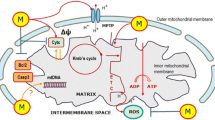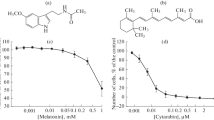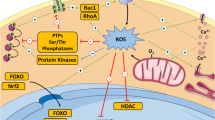Abstract
Melatonin is an indoleamine secreted by the pineal gland that shows multiple tasks. This ubiquitously acting free radical scavenger has recently been shown to stimulate the production of reactive oxygen species (ROS) in tumour cells, making them undergo apoptosis, whilst it prevents apoptosis in healthy cells. The mechanisms by which melatonin exerts these dual actions are, however, not yet clearly understood. Thus, the aim of this study was to further investigate how melatonin can enhance oxidative stress-induced apoptosis in a leukaemia cell line. The results show that melatonin increased the apoptotic effects of H2O2 in human myeloid HL-60 cells as assessed by cellular viability, mitochondrial permeability transition induction, mitochondrial membrane depolarization, ROS generation, caspases 3, 8 and 9 activity, phosphatidylserine externalization, and DNA fragmentation techniques. When healthy leucocytes were exposed to H2O2, melatonin increased the viability of the cells. Taken together, the findings indicate that melatonin is a potential physiological tool capable of protecting healthy cells from chemotherapy-induced ROS production as well as inducing tumour cell death. Because cancer cells manifest increased oxidative stress as a result of their elevated metabolism, the use of melatonin may be useful in impairing their ROS buffering capacity.






Similar content being viewed by others
References
Reiter RJ, Tan DX, Fuentes-Broto L (2010) Melatonin: a multitasking molecule. Prog Brain Res 181:127–151
Paredes SD, Korkmaz A, Manchester LC, Tan DX, Reiter RJ (2009) Phytomelatonin: a review. J Exp Bot 60:57–69
Jou MJ, Peng TI, Yu PZ, Jou SB, Reiter RJ, Chen JY, Wu HY, Chen CC, Hsu LF (2007) Melatonin protects against common deletion of mitochondrial DNA-augmented mitochondrial oxidative stress and apoptosis. J Pineal Res 43:389–403
Sainz RM, Mayo JC, Rodriguez C, Tan DX, Lopez-Burillo S, Reiter RJ (2003) Melatonin and cell death: differential actions on apoptosis in normal and cancer cells. Cell Mol Life Sci 60:1407–1426
Cos S, Mediavilla MD, Fernández R, González-Lamuño D, Sánchez-Barceló EJ (2002) Does melatonin induce apoptosis in MCF-7 human breast cancer cells in vitro? J Pineal Res 32:90–96
Pirozhok I, Meye A, Hakenberg OW, Fuessel S, Wirth MP (2010) Serotonin and melatonin do not play a prominent role in the growth of prostate cancer cell lines. Urol Int 84:452–460
Dziegiel P, Podhorska-Okolow M, Surowiak P, Ciesielska U, Rabczynski J, Zabel M (2003) Influence of exogenous melatonin on doxorubicin-evoked effects in myocardium and in transplantable Morris hepatoma in rats. In Vivo 17:325–328
Pawlikowski M, Winczyk K, Karasek M (2002) Oncostatic action of melatonin: facts and question marks. Neuro Endocrinol Lett 23:24–29
Sainz RM, Mayo JC, Reiter RJ, Antolín I, Esteban MM, Rodríguez C (2000) Melatonin regulates glucocorticoid receptor: an answer to its antiapoptotic action in thymus. FASEB J 13:1547–1556
Espino J, Bejarano I, Ortiz A, Lozano GM, García JF, Pariente JA, Rodríguez AB (2010) Melatonin as a potential tool against oxidative damage and apoptosis in ejaculated human spermatozoa. Fertil Steril 94:1915–1917
Wolfler A, Caluba HC, Abuja PM, Dohr G, Schauenstein K, Liebmann PM (2001) Prooxidant activity of melatonina promotes Fas-induced cell death in human leukemic Jurkat cells. FEBS Lett 502:127–131
Bejarano I, Espino J, Barriga C, Reiter RJ, Pariente JA, Rodríguez AB (2011) Pro-oxidant effect of melatonin in tumour leucocytes: relation with its cytotoxic and pro-apoptotic effects. Basic Clin Pharmacol Toxicol 108:14–20
Büyükavci M, Ozdemir O, Buck S, Stout M, Ravindranath Y, Savaşan S (2006) Melatonin cytotoxicity in human leukemia cells: relation with its pro-oxidant effect. Fundam Clin Pharmacol 20:73–79
Paternoster L, Radogna F, Accorsi A, Cristina Albertini M, Gualandi G, Ghibelli L (2009) Melatonin as a modulator of apoptosis in B-lymphoma cells. Ann NY Acad Sci 1171:345–349
Wenzel U, Nickel A, Daniel H (2005) Melatonin potentiates flavone-induced apoptosis in human colon cancer cells by increasing the level of glycolytic end products. Int J Cancer 116:236–242
Albertini MC, Radogna F, Accorsi A, Uguccioni F, Paternoster L, Cerella C, De Nicola M, D’Alessio M, Bergamaschi A, Magrini A, Ghibelli L (2006) Intracellular pro-oxidant activity of melatonin deprives U937 cells of reduced glutathione without affecting glutathione peroxidase activity. Ann NY Acad Sci 1091:10–16
Pelicano H, Carney D, Huang P (2004) ROS stress in cancer cells and therapeutic implications. Drug Resist Updat 7:97–110
Tien Kuo M, Savaraj N (2006) Roles of reactive oxygen species in hepatocarcinogenesis and drug resistance gene expression in liver cancers. Mol Carcinog 45:701–709
Liu X, Chen Z, Chua CC, Ma YS, Youngberg GA, Hamdy R, Chua BH (2002) Melatonin as an effective protector against doxorubicin-induced cardiotoxicity. Am J Physiol Heart Circ Physiol 283:H254–H263
Fan LL, Sun GP, Wei W, Wang ZG, Ge L, Fu WZ, Wang H (2010) Melatonin and doxorubicin synergistically induce cell apoptosis in human hepatoma cell lines. World J Gastroenterol 16:1473–1481
Casado-Zapico S, Rodriguez-Blanco J, García-Santos G, Martín V, Sánchez-Sánchez AM, Antolín I, Rodriguez C (2010) Synergistic antitumor effect of melatonin with several chemotherapeutic drugs on human Ewing sarcoma cancer cells: potentiation of the extrinsic apoptotic pathway. J Pineal Res 48:72–80
Espino J, Bejarano I, Redondo PC, Rosado JA, Barriga C, Reiter RJ, Pariente JA, Rodríguez AB (2010) Melatonin reduces apoptosis induced by calcium signaling in human leukocytes: evidence for the involvement of mitochondria and Bax activation. J Membr Biol 233:105–118
Petronilli V, Miotto G, Canton M, Brini M, Colonna R, Benardi P, di Lisa F (1999) Transient and long-lasting openings of the mitochondrial permeability transition pore can be monitored directly in intact cells by changes in mitochondrial calcein fluorescence. Biophys J 76:725–734
Bejarano I, Redondo PC, Espino J, Rosado JA, Paredes SD, Barriga C, Reiter RJ, Pariente JA, Rodríguez AB (2009) Melatonin induces mitochondrial-mediated apoptosis in human myeloid HL-60 cells. J Pineal Res 46:392–400
Bejarano I, Espino J, González-Flores D, Casado JG, Redondo PC, Rosado JA, Barriga C, Rodríguez AB, Pariente JA (2009) Role of calcium signal on hydrogen peroxide-induced apoptosis in human myeloid HL-60 cells. Int J Biomed Sci 5:246–256
Tsujimoto Y, Nakagawa T, Shimizu S (2006) Mitochondrial membrane permeability transition and cell death. Biochim Biophys Acta 1757:1297–1300
Berger J (2008) A two-clock model of circadian timing in the immune system of mammals. Pathol Biol (Paris) 56:286–291
Sánchez S, Sánchez CL, Paredes SD, Rodríguez AB, Barriga AB (2008) The effect of tryptophan administration on the circadian rhythms of melatonin in plasma and the pineal gland in rats. J Appl Biomed 6:177–186
Toyokuni S, Okamoto K, Yodoi J, Hiai H (1995) Persistent oxidative stress in cancer. FEBS Lett 358:1–3
Hileman EO, Achanta G, Huang P (2001) Superoxide dismutase: anemerging target for cancer therapeutics. Expert Opin. Ther. Targets 5:679–710
Hileman EO, Liu J, Albitar M, Keating MJ, Huang P (2004) Intrinsic oxidative stress in cancer cells: a biochemical basis for therapeutic selectivity. Cancer Chemother Pharmacol 53:209–219
Kanbagli O, Ozdemirler G, Bulut T, Yamaner S, Aykac-Toker G, Uysal M (2000) Mitochondrial lipid peroxides and antioxidant enzymes in colorectal adenocarcinoma tissues. Jpn J Cancer Res 91:1258–1263
Storey KB (1996) Oxidative stress: animal adaptations in nature. Braz J Med Biol Res 29:1715–1733
Trubiani O, Recchioni R, Moroni F, Pizzicannella J, Caputi S, Di Primio R (2005) Melatonin provokes cell death in human B-lymphoma cells by mitochondrial-dependent apoptotic pathways activation. J Pineal Res 39:425–431
Martín-Renedo J, Mauriz JL, Jorquera F, Ruiz-Andrés O, González P, González-Gallego J (2008) Melatonin induces cell cycle arrest and apoptosis in hepatocarcinoma HepG2 cell line. J Pineal Res 45:532–540
Perez-Cruz I, Cárcamo JM, Golde DW (2007) Caspase-8 dependent TRAIL-induced apoptosis in cancer cell lines is inhibited by vitamin C and catalase. Apoptosis 12:225–234
Suhara T, Fukuo K, Sugimoto T, Morimoto S, Nakahashi T, Hata S, Shimizu M, Ogihara T (1998) Hydrogen peroxide induces up-regulation of Fas in human endothelial cells. J Immunol 160:4042–4047
Chetsawang B, Putthaprasart C, Phansuwan-Pujito P, Govitrapong P (2006) Melatonin protects against hydrogen peroxide-induced cell death signaling in SH-SY5Y cultured cells: involvement of nuclear factor kappa B, Bax and Bcl-2. J Pineal Res 41:116–123
Juknat AA, Mendez M del V, Quaglino A, Fameli CI, Mena M, Kotler ML (2005) Melatonin prevents hydrogen peroxide-induced Bax expression in cultured rat astrocytes. J Pineal Res 38:84–92
Acknowledgments
This study was supported by the Junta de Extremadura (PRI07-A024) and the Ministerio de Ciencia e Innovación-Fondo Europeo de Desarrollo Regional grants (BFU2007-60091 and BFU2010-15049). I. Bejarano and S.D. Paredes are the beneficiaries of grants from the Consejería de Economía, Comercio e Innovación-Fondo Social Europeo (Junta de Extremadura, PRE06070 and REI09009, respectively). J. Espino is a beneficiary of a grant from the Ministerio de Ciencia e Innovación (AP2009-0753).
Author information
Authors and Affiliations
Corresponding author
Rights and permissions
About this article
Cite this article
Bejarano, I., Espino, J., Marchena, A.M. et al. Melatonin enhances hydrogen peroxide-induced apoptosis in human promyelocytic leukaemia HL-60 cells. Mol Cell Biochem 353, 167–176 (2011). https://doi.org/10.1007/s11010-011-0783-8
Received:
Accepted:
Published:
Issue Date:
DOI: https://doi.org/10.1007/s11010-011-0783-8




